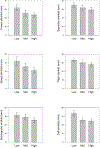Variation in dietary intake and body fatness by socioeconomic status among women in the context of Costa Rican nutrition transitions
- PMID: 31218982
- PMCID: PMC6923611
- DOI: 10.1017/S0021932019000403
Variation in dietary intake and body fatness by socioeconomic status among women in the context of Costa Rican nutrition transitions
Abstract
The Nutrition Transition model posits that vegetable oils, animal source foods (ASFs) and caloric sweeteners contribute to increases in adiposity and hence body mass index. Body mass index (BMI) is increasing more rapidly among Latin American populations of low versus high socioeconomic status (SES). The objectives of this study among Costa Rican women were to: (1) compare indicators of adiposity and dietary intake by SES and (2) evaluate the relationship between intake of foods high in vegetable oils, ASFs or caloric sweeteners and body fatness. This cross-sectional study, conducted in 2014-2015, included 128 low-, middle- and high-SES non-pregnant, non-lactating women aged between 25 and 45 years with 1-4 live births. Anthropometry was used to assess BMI, body composition and body fat distribution. Dietary recalls (n = 379) were used to assess dietary intake. Percentage body fat was greater in low- versus high-SES women (31.5 ± 3.9 vs 28.2 ± 4.7%). Skinfold measurements at four sites on the upper and lower body were greater in low- versus high-SES women. Body mass index did not vary in low- versus high-SES women. Intake frequency of foods high in vegetable oils was greater in low- and middle- (1.8 and 1.8 times/day, respectively) versus high- (1.1 times/day) SES women. For individual foods, intake frequency varied significantly by SES for high-fat condiments, fried vegetables, dairy, sweetened coffee/tea and pastries and desserts. Intake frequency of Nutrition Transition food categories was not associated with percentage body fat after adjustment for energy intake. Indicators of body composition provide additional information beyond BMI that are useful in understanding SES-adiposity associations in Latin America. Approaches to understanding diet and adiposity in Latin America that focus on vegetable oils, ASFs and caloric sweeteners should consider within-country variation in the pace of the Nutrition Transition, especially when explaining variation in adiposity by SES.
Keywords: Latin America; Nutrition transition; Socioeconomic status.
Conflict of interest statement
Disclosure of interest: The authors have no conflicts of interest to declare.
Figures


Similar articles
-
Using the protein leverage hypothesis to understand socioeconomic variation in obesity.Am J Hum Biol. 2017 May 6;29(3). doi: 10.1002/ajhb.22953. Epub 2017 Jan 25. Am J Hum Biol. 2017. PMID: 28121382
-
Socioeconomic Status Impact on Diet Quality and Body Mass Index in Eight Latin American Countries: ELANS Study Results.Nutrients. 2021 Jul 14;13(7):2404. doi: 10.3390/nu13072404. Nutrients. 2021. PMID: 34371915 Free PMC article.
-
Association between commercial and traditional sugar-sweetened beverages and measures of adiposity in Costa Rica.Public Health Nutr. 2012 Aug;15(8):1347-54. doi: 10.1017/S1368980012001000. Epub 2012 Apr 12. Public Health Nutr. 2012. PMID: 22494394 Free PMC article.
-
[Simple obesity in children. A study on the role of nutritional factors].Med Wieku Rozwoj. 2006 Jan-Mar;10(1):3-191. Med Wieku Rozwoj. 2006. PMID: 16733288 Review. Polish.
-
Effects of Socioeconomic Status on Nutrition in Asia and Future Nutrition Policy Studies.J Nutr Sci Vitaminol (Tokyo). 2015;61 Suppl:S66-8. doi: 10.3177/jnsv.61.S66. J Nutr Sci Vitaminol (Tokyo). 2015. PMID: 26598891 Review.
Cited by
-
Diet-Attributable Greenhouse Gas Emissions and Acute Myocardial Infarction in Costa Rica Heart Study.Nutrients. 2023 Dec 30;16(1):138. doi: 10.3390/nu16010138. Nutrients. 2023. PMID: 38201967 Free PMC article.
-
[Intake of processed meats by Costa Rican women: effect of socioeconomic status].Rev Biol Trop. 2021 Oct 1;69(2):665-677. doi: 10.15517/rbt.v69i2.45428. Epub 2021 May 20. Rev Biol Trop. 2021. PMID: 36742162 Free PMC article. Spanish.
-
The Relationship Between Modeling, Caregiver Education, and Diverse Diet in Costa Rican Preschool Children.Nutrients. 2025 Jun 24;17(13):2087. doi: 10.3390/nu17132087. Nutrients. 2025. PMID: 40647192 Free PMC article.
-
A Traditional Costa Rican Adolescents' Diet Score Is a Valid Tool to Capture Diet Quality and Identify Sociodemographic Groups With Suboptimal Diet.Front Public Health. 2021 Aug 12;9:708956. doi: 10.3389/fpubh.2021.708956. eCollection 2021. Front Public Health. 2021. PMID: 34458228 Free PMC article.
References
-
- Agüero MLA (2009) National Nutrition Survey, Costa Rica 2008–2009. [In Spanish]. Ministry of Health San Jose, Costa Rica,
-
- Aguilar-Farias N, Martino-Fuentealba P, Carcamo-Oyarzun J, Cortinez-O’ryan A, Cristi-Montero C, Von Oetinger A & Sadarangani KP (2018) A regional vision of physical activity, sedentary behaviour and physical education in adolescents from Latin America and the Caribbean: results from 26 countries. International Journal of Epidemiology. DOI: 10.1093/ije/dyy033. - DOI - PubMed
Publication types
MeSH terms
Substances
Grants and funding
LinkOut - more resources
Full Text Sources
Medical

